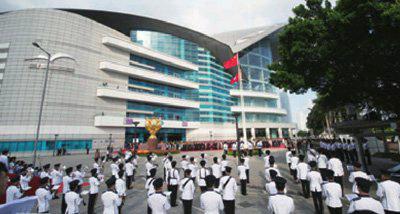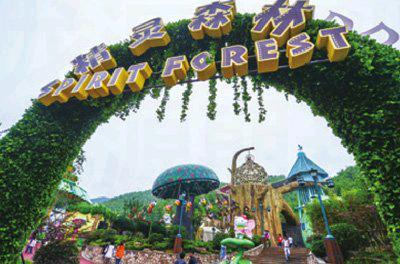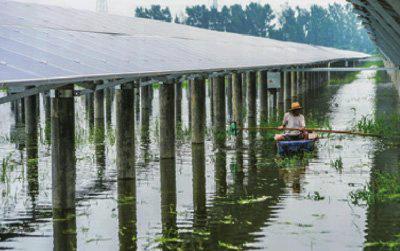Anniversary Celebration
2015-07-22
A flag-raising ceremony is held at the Golden Bauhinia Square in the Hong Kong Special Administrative Region on July 1 to celebrate the 18th anniversary of Hong Kongs return to China.
Hong Kong Chief Executive Leung Chun-ying attended the ceremony. Government Flying Service helicopters provided a simultaneous fly-by over the harbor. Local people witnessed the solemn ceremony.
CPC Members
The Communist Party of China (CPC) had a total of 87.793 million members at the end of 2014, the Organization Department of the CPC Central Committee said on June 29.
CPC members increased by 1.1 million compared to 2013, up 1.3 percent. The grassroots Party units increased by 56,000 to 4.36 million, also up 1.3 percent, the department said in a communique published ahead of the 94th anniversary of CPCs founding on July 1.
In 2014 the CPC recruited 2.057 million new members. A total of 1.693 million new members were under the age of 35, accounting for 82.3 percent of all new members in 2014, up 0.6 percentage points from that of 2013. A total of 38.8 percent of new members have college degrees or above, up 2.6 percentage points from that of 2013.
The Party had 21.672 million female members as of the end of 2014, up 0.4 percentage points. A total of 37.755 mil- lion members, or 43 percent of the total, have college degrees or above, up 1.4 percentage points.
Pension Fund Investment
Absolute safety must be guaranteed as China considers diversifying its massive pension fund investments to bolster their value, the Ministry of Human Resources and Social Security (MHRSS) said on June 30.
In China, urban employees pay for their pension before retirement and usually get a pension equal to about half of their previous salary.
Money in the fund, roughly 90 percent of the countrys total social security fund pool, previously restricted deposits to banks and investments to treasury bonds, respectively. Both options offer important options for safeguarding the moneys safety, but the investment channels dont allow much relative growth.
The fund can also be invested in the nations big projects and key enterprise equities, but restricts the maximum proportion of such investments to 20 percent of total net assets.
Market for Relics
China announced on June 30 its first market for returned-cultural relics had opened at the Beijing Tianzhu Free Trade Zone.
Li Yanling, deputy head of the bonded zone, said the market would enjoy favorable customs clearance procedures and tax exemptions. It will hold regular auctions, exhibitions and trade fairs that will be open to international organizations.
The market will offer services such as identification and storage of cultural relics.
“At least 10 million Chinese cultural relics have been stolen and smuggled out of the country. A substantial amount cannot be returned through the official channels,” said Wang Yudong, Deputy General Manager of Beijing Gehua Cultural Development Group, which operates the relic market.
Housing Renovation
The State Council issued a guideline on June 30 demanding local authorities formulate a three-year plan to accelerate the renovation of run-down areas and dilapidated rural houses.
China plans to build 18 million apartments in urban areas and renovate 10.6 million rural houses between 2015 and 2017, as part of efforts to improve living conditions and boost investment and consumption amid the economic slowdown.
Earlier data from the Ministry of Housing and Urban-Rural Development showed the Central Government has allocated 185.9 billion yuan ($30.5 billion) to the renovation projects so far this year. It pumped in 450.6 billion yuan($72.7 billion) between the start of 2008 and the end of 2014.
Qomolangma Base
The base camp on the north face of Mount Qomolangma in Southwest Chinas Tibet Autonomous Region will reopen to climbers on July 1, according to local tourism authorities.
The site was closed for safety reasons following the 8.1-magnitude earthquake on April 25 that killed climbers and guides on the Nepal side of the mountain, known as Everest in the West.
Despite the reopening, some roads leading to the base camp will be subject to periodic traffic controls or remain closed, said a spokesperson with the tourism bureau of Tingri County on June 30.
The base camp, located 5,200 meters above sea level, saw a record 59,100 visitors in 2014.
National Security Law
The top legislature on July 1 adopted a new national security law, which highlighted cybersecurity and demanded the establishment of a coordinated, efficient crisis management system.
A total of 155 lawmakers at a bimonthly session of the National Peoples Congress (NPC) Standing Committee voted on the legislation, 144 were in favor, and one abstained.
The law included a cyberspace“sovereignty” clause, which covered assets and activities in space, the deep sea and polar regions.
Chinas first national security law took effect in 1993 and primarily regulated the national security agencies, and their counterespionage work. It was renamed the Counterespionage Law in November last year.
Lotus Garden
People visit the lotus flowers at the Zhuozheng Yuan, a famous ancient garden in Suzhou, Jiangsu Province, on June 28. The 20th Lotus Festival kicked off here and more than 100 sorts of lotus are showed in the garden.
Easier Trip
A Taiwan resident shows her Mainland Travel Permit of Taiwan Residents (MTP) after arriving at the Fuzhou Changle International Airport in Fuzhou, capital of southeast Chinas Fujian Province, on July 1.
Taiwan residents have been permitted to enter the mainland only with MTP and no longer have to apply for endorsement as of July 1, according to a new regulation on Chinese peoples travel between Taiwan and the mainland.
Weighing In
The National Health and Family Planning Commission released the 2015 Report on Chinese Nutrition and Chronic Disease on June 30. The report shows that 9.6 percent of those aged 6 to 17 were overweight. This doubled the rate in 2002.
The obesity rate among adults was 11.9 percent, a rise of 67.6 percent from 2002, and 6.4 percent among children and adolescents, a rate tripling that of 2002.
It took researchers one and a half years to finish the report, which was based on data from the Chinese Center for Disease Control and Prevention, the National Cancer Center and other institutes.
China had its first public nutrition and health survey in 2002, with the results announced in 2004. Since 2004, the nation has carried out field surveys every three years to collect data on causes of death, chronic disease and other health issues.
Adjusting to Slower Pace
Growth in China is expected to decelerate to 7.1 percent in 2015 and 6.9 percent by 2017, reflecting a growth trajectory that is slower but more balanced and sustainable—a “new normal” for the worlds second largest economy—according to the World Banks China Economic Update released on July 1.
“In the short run, the slowdown in Chinas economic growth means the government is making inroads with structural adjustments and policy efforts to address financial vulnerabilities. Over the medium term, these efforts are helping China gradually shift its growth model from manufacturing to services, from investment to consumption, and from exports to domestic spending,”said Karlis Smits, senior economist for China at the World Bank and main author of the report.
Government policies to slow rapid credit growth, contain shadow banking and limit borrowing by local governments have led to slower investment growth in areas such as real estate, the report said.
“In 2015, it remains a priority for China to balance reforms and shortterm growth, because large-scale, broad-based stimulus measures aimed at supporting growth may conflict with efforts to make the economy more sustainable in the medium run,” said Chorching Goh, lead economist for China at the World Bank.
Chinas economic structure is slowly changing. On the one hand, economic activity remains constrained by overcapacity in heavy industries, decelerating export growth and regulatory tightening on non-traditional lending. The real estate market remains weak, with excess inventory and, in most cities, softening property prices.
On the other hand, growth in services remained robust, especially in advanced services such as banking and insurance. And in most recent years, consumption has grown slightly faster than investment.
To keep the economy on the right track, the report recommends, for example, a better allocation of credit, which in turn requires financial sector reforms. The investment-driven growth model helped Chinas economy take off, but reforms are needed to enable the financial system to support sectors that can maintain reasonable growth over the medium-term.
Home Sweet Kitty
Tourists experience various recreation facilities in the Hello Kitty Theme Park in Anji County, east Chinas Zhejiang Province.
Opened on July 1, the park is first of its kind in China. Covering an area of 1.6 square km and with an investment of 2 billion yuan ($322 million), the park is expected to receive more than 1 million visitors every year.
Belt and Road Bonds
On July 1, the Bank of Chinas (BOC) Abu Dhabi branch listed its 2 billion yuan ($322 million) bonds for the Belt and Road Initiative on Nasdaq Dubai, the Middle Easts only international exchange.
The 2-billion-yuan issuance made up a part of bonds raised by the BOC in June.
On June 25, the BOC said it had successfully raised the equivalent of$4 billion from the international bond markets for the Belt and Road Initiative, which aims to recreate the Silk Road and boost cooperation with countries along the ancient trading route.
The money will support projects to boost infrastructure links between Asia and Europe, the BOC said.
This is the biggest amount of bonds issued at one time by the BOC abroad, in four currencies—the yuan, the U.S. dollar, the Singapore dollar and the euro. The bonds contain fixed interest securities and floating interest, with diversified terms to maturity.
The BOC plans to increase its credit scale to $100 billion in the coming three years for Belt and Road projects.
Tian Jun, general manager of the Abu Dhabi branch of BOC, said the successful listing on Nasdaq Dubai shows international investors confidence in the huge opportunities that Chinas Belt and Road initiative brings to the United Arab Emirates (UAE).
Essa Kazim, the governor of the Dubai international financial center, said Dubai will further strengthen its leadership position in linking the Middle East financial markets to China and other markets for the benefit of all.
In 2014, China surpassed India to become the biggest trade partner of the UAE as bilateral trade hit nearly$50 billion.
Gone Green Fishing
A fisherman rows down a pond in Tongxiang, east Chinas Zhejiang Province. Above the pond are solar photovoltaic panels.
On June 30, the first overwater solar power station in Zhejiang hooked up to the grid. The power station, consisting of 40,000 solar panels and with an investment of 100 million yuan ($16.12 million), can generate 10 million kilowatt-hours of electricity annually, saving 3,500 tons of standard coal and correspondingly reducing emission of 9,200 tons of carbon dioxide.
Running Banks in Europe
On June 30 in Paris, China Construction Bank (CCB), one of the largest Chinese banks, announced it would open four branches in Europe.
These branches are located in Paris, Amsterdam, Barcelona and Milan, Wang Hongzhang, Chairman of the Board of Directors of CCB said, noting that their opening constitutes an important step toward the banks internationalization.
Wang said CCBs European branches will, in the short and medium terms, focus on providing services for Chinese enterprises and European companies.
Wang noted that CCB branches in Europe will, among others, cover the commercial financing, bank deposit and cash transactions.
By the end of the first half of 2015, the volume of CCBs assets reached 17.48 trillion yuan ($2.82 trillion), and its profits amounted to nearly 67.13 billion yuan ($10.82 billion).
Coffee Transportation
Southwest Chinas Yunnan Province on July 1 began a container train service carrying coffee beans and other products to Europe.
With 2,050 tons of coffee on board, the train set off from the provincial capital of Kunming on July 1 and is scheduled to arrive in Rotterdam in 15 days. Previously, Yunnans coffee went to Europe by sea, which usually takes over 30 days.
The train will cross the border at the Alataw Pass in northwest Chinas Xinjiang Uygur Autonomous Region before passing through Kazakhstan, Russia, Belarus, Poland and Germany, on its way to the Netherlands.
Two return trips will be made every month, and it is estimated that 24,000 tons of coffee will be sent to Europe this year, said Liu Baisheng, head of the Kunming Railway Bureau, adding that the amount will be expanded to 140,000 tons and 300,000 tons in 2016 and 2017, respectively, he said.
Yunnan boasts 99 percent of Chinas coffee output. The province exported 67,200 tons of coffee in 2014.
PMI in June
Chinas manufacturing business activity remained stable in June, with an important index remaining in expansion territory, according to data on July 1.
The manufacturing purchasing managers index (PMI), a key measure of factory activity in China, posted at 50.2 in June, unchanged from May, according to data compiled by the National Bureau of Statistics (NBS) and the China Federation of Logistics and Purchasing.
A reading above 50 indicates expansion, and Chinas manufacturing PMI figures have been above the expansion/contraction threshold for the last four months.
The production subindex posted at 52.9, flat from the previous month. But the second quarter was better than the first, said NBS statistician Zhao Qinghe.
As a sign of successful economic restructuring, growth of hi-tech and consumer products manufacturing continued to beat overall manufacturing, while high energy-consuming industries saw slower growth, Zhao said.
In addition, Chinas service sector activity improved in June, an official monthly survey showed on July 1.
The PMI for the non-manufacturing sector expanded to 53.8 in June, up from 53.2 for May.
